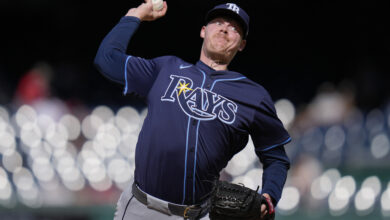
Are Cubs on Leading Edge of New Trend in Starting Pitching?
I know we focus on the Cubs around here, but every once in a while I actually deign to read something not directly related to this site’s namesake team. I might even find it on a — gasp! — non-sports site. Crazy, I know. So it was that I saw a headline that captured my eye, and not in a clickbait-y sort of way either. And it was a sports article from Business Insider, of all places.
The Royals and Rays are reinventing how teams use starting pitchers and it’s going to drive baseball traditionalists crazy, it read, enticing me to find out just what kind of anti-meatball enlightenment might lie beyond the click of a mouse.
What I found in Cork Gaines’ piece didn’t necessarily trigger any paradigmatic shifts inside this thick skull of mine, but it was certainly interesting. Perhaps not as interesting as the fact that Gaines “has authored several scientific publications on the forensic DNA and evolution of whales,” but a quality read nonetheless.
In case you haven’t or won’t read the whole post, the gist of it is that the Rays and Royals are managing the usage of their rotations based more on total batters face than on pitch counts. The logic behind it is pretty solid too, since hitters’ OPS numbers jump significantly when facing a pitcher for the third time in a game.
Both teams cited in the article boast rotations that face fewer than 24 batters per start on average. We normally associate shorter outings with poor performance, but in the case of the Rays and Royals, the decreased workloads are proactive in nature. In other words, starters are being lifted before their performance can take a turn south.
As Gaines wrote, “By recognizing this trend [in OPS increase in 3rd AB], the starting pitchers for the Rays and Royals lead the American League in the fewest batters faced per start, something never seen by successful teams.” My only gripe here is that he doesn’t cite historical data and I’m too lazy to do that level of research on my own. That said, I’ll take his word for it.
Here are a couple graphics from the Business Insider post detailing the Rays’ and Royals’ departure from the norm:
Okay, that’s all well and good, but we’re only seeing AL teams here. I say that not to question the validity of the graphic or the article — after all, the nuances of the various leagues make direct comparisons between the two a little dicey — but to explain my thought process in writing my own piece.
The Cubs have had some really notable pitching performances of late, but I had just written the other day about how rare complete games have become in general and we’ve all heard concerns about their starters not going deep enough on a regular basis. What’s more, I wondered whether Joe Maddon’s influence might link the decisions of the Rays and Cubs.
In terms of batters faced per game by starting pitchers, the Cubs are tied with the Yankees at 24.4. Interestingly enough, they’re 4th in the NL as well behind the Marlins (23.9), Rockies (24.1), and Reds (24.2). Of course, those three squads rank in the bottom third of the majors in FIP and the Cubs rank 5th. So I guess you still need talent to make this strategy work. Weird.
I’m not going to say that this is a gimmick or a fluke, though it does strike me in much the same way as the talk about all the NBA teams wanting to go small and quick after seeing what Golden State did this season. I think we can over-generalize things sometimes to the point that we actually forget to include the exploits of the players on the field or floor.
Oh, there’s one other thing at play here too: the bullpens of the respective teams. If you’ve got a great rotation and a shoddy ‘pen, is it really a great strategy to take the ball out of your starters’ hands earlier? All things being equal, I’ll take Jake Arrieta for the third time against any hitter in the league over Brian Schlitter in his first go-round.
The Rays boast a rotation that includes Chris Archer and Jake Odorizzi, both of whom have sub-2.50 ERA’s, and the Royals have a bullpen that is the envy of all 29 other teams. I’m just wondering whether perhaps strategy is being overstated to the point that talent isn’t really getting its due.
That said, I know that advanced metrics have allowed baseball to become more efficient and there’s still plenty of room for to streamline processes here and there. So while I’m not ready to put a great deal of stock into what Gaines posits, this is certainly an interesting concept and one that I think bears following.
I love counter-intuitive stuff as sort of a general rule too, so I’m going to keep an eye on this to see whether it progresses.



